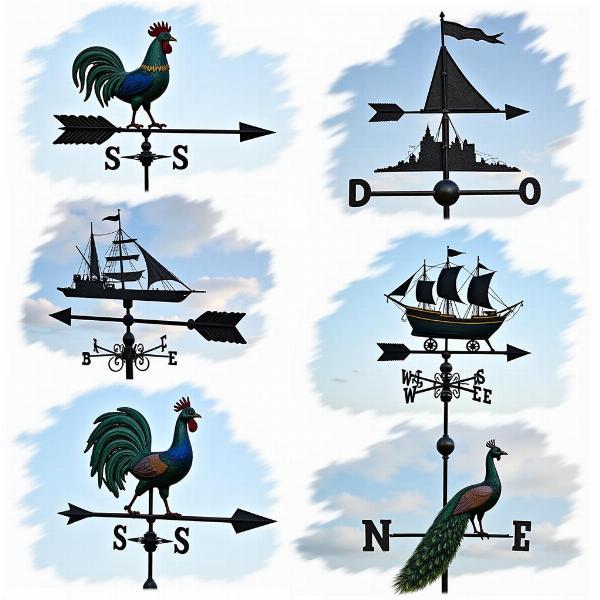Understanding the meaning and significance of a weather vane in Hindi unveils a fascinating blend of meteorology, language, and cultural nuances. For those seeking the Hindi equivalent of “weather vane,” this guide will provide a detailed exploration of its various translations, cultural context, and practical applications.
What Does Weather Vane Mean in Hindi?
The most common Hindi translation for “weather vane” is मौसम फलक (mausam falak). “Mausam” means weather, while “falak” refers to a board or plate. This term accurately describes the function of a weather vane – a plate-like object that indicates the wind’s direction. Other less common, but equally valid translations include हवा का रुख बताने वाला यंत्र (hava ka rukh batane wala yantra), literally meaning “instrument that shows the direction of the wind,” and पवन दिशा सूचक (pavan disha soochak), meaning “wind direction indicator.” Each term reflects the device’s purpose in a slightly different way.
The Significance of Weather Vanes in Indian Culture
While weather vanes are not traditionally as prevalent in Indian architecture as in some Western cultures, their function remains universally understood. Farmers, sailors, and anyone relying on weather forecasting appreciate the importance of understanding wind direction. In rural India, observing natural indicators like wind direction remains crucial for predicting weather patterns and planning agricultural activities. Even today, understanding wind direction plays a vital role in various fields, from aviation to construction.
Different Types of Weather Vanes
Weather vanes come in various shapes and sizes, from simple arrows to elaborate figures of animals, ships, or even mythological creatures. The design often reflects local traditions and artistic styles. While functionality remains the core principle, the aesthetic element adds a layer of cultural significance.
 Different Types of Weather Vanes in India
Different Types of Weather Vanes in India
How Does a Weather Vane Work?
A weather vane operates on a straightforward principle: the tail section, offering larger surface area, catches the wind, causing the arrowhead to point into the wind. This indicates the direction from which the wind is blowing. Understanding this principle is crucial for interpreting weather patterns and predicting changes.
Why is Knowing the Wind Direction Important?
Knowing the wind direction is crucial for various reasons:
- Agriculture: Farmers use wind direction to predict rainfall and plan irrigation.
- Aviation: Pilots rely on wind direction for takeoff and landing.
- Sailing: Sailors utilize wind direction for navigation.
- Weather Forecasting: Meteorologists incorporate wind direction in their weather models.
Weather Vane: Beyond its Literal Meaning
The term “weather vane” can also be used metaphorically to describe someone who frequently changes their opinions or allegiances, much like a weather vane shifts with the wind. This figurative usage adds another layer of meaning to the term.
Conclusion
Understanding “weather vane meaning in Hindi” encompasses both its literal and metaphorical interpretations. Whether referring to the meteorological instrument – मौसम फलक (mausam falak) – or its symbolic representation of change, the term holds significance in both practical and figurative contexts.
FAQs
- What is the most common Hindi word for “weather vane”? The most common word is मौसम फलक (mausam falak).
- Why are weather vanes important? They indicate wind direction, which is crucial for weather prediction, agriculture, aviation, and sailing.
- What are some other Hindi translations for “weather vane”? Other translations include हवा का रुख बताने वाला यंत्र (hava ka rukh batane wala yantra) and पवन दिशा सूचक (pavan disha soochak).
- Can “weather vane” be used metaphorically? Yes, it can describe someone who frequently changes their opinions.
- Where can I find more information about weather vanes in Hindi? You can explore online resources or consult Hindi dictionaries and encyclopedias.
- How does a weather vane indicate wind direction? The tail catches the wind, causing the arrowhead to point into the wind.
- Are weather vanes common in Indian architecture? While not as prevalent as in some Western cultures, they are understood and utilized.
Meaning-Hindi.in is your premier destination for all your Hindi translation needs. We offer a comprehensive suite of translation services, from business and legal documents to technical manuals and website localization. Our team of expert linguists ensures accurate, culturally sensitive translations for a diverse clientele. Whether you need document translation, website localization, or specialized language services, Meaning-Hindi.in delivers exceptional quality and fast turnaround times. Contact us today at [email protected] or call us at +91 11-4502-7584 to discuss your translation requirements. Let Meaning-Hindi.in bridge the language gap for you.